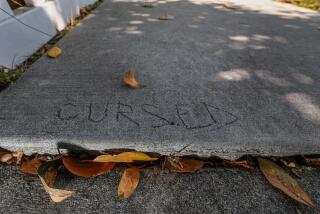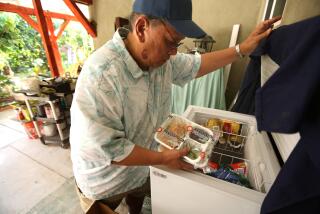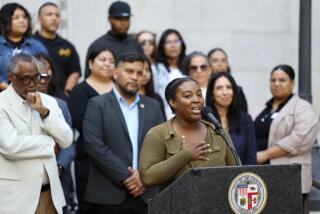‘Handyworker’ Program Comes With All the Fixings
- Share via
Robert Vinton was in a Catch-22 situation.
Recuperating from a broken hip and unable to drive, the West Hills man who lives alone searched for ways to get to physical therapy appointments.
A private transportation service that would take him and his wheelchair down his front steps and into a van was too expensive.
A more affordable city-sponsored van service required that he wait at the curb. With no one to help him out of his house, though, that wasn’t an option.
The solution to his dilemma came in the form of a wheelchair ramp recently installed at no cost to him as part of the city’s Handyworker program.
“I’m mobile now. It makes a big difference,” said Vinton, 77, a retired manager of facilities planning for Hughes Aircraft. “I’m anxious to do my physical therapy, which I should have started in September.”
In addition to the 10-foot-long ramp at his front door, workers installed a shorter ramp leading to the backyard, as well as safety “grab” bars in the bathroom and a new garage door.
A patio door and two large windows were re-screened, the kitchen was repainted, closet doors were fixed and his mailbox was lowered to make it easier to reach from his wheelchair.
“I was thrilled with it,” Vinton said of the service. “I was surprised they did all this.”
Under the Los Angeles Handyworker program, low-income seniors and disabled people can apply to have necessary repairs made to their homes.
Repairs on 1,675 homes citywide were performed without charge last year, averaging $2,430 per home, officials said. The city contracts with eight agencies to book appointments and make repairs.
Program officials say the repairs not only make homes safer, but may prevent or delay some frail seniors from having to move into nursing homes.
There are other advantages too, officials say. By having the work done by licensed workers, seniors and the disabled don’t become prey for unscrupulous vendors or predatory lenders, and the whole neighborhood benefits when homes are kept up.
“It’s a nuts-and-bolts program. It’s not like putting in park benches that seniors might use,” said Ron Carreira, project manager of the Handyworker program for the East Valley, which is administered by the San Fernando Valley Interfaith Council. “These seniors are fortunate to have their houses, but in many cases, that’s all they’ve got.”
Requests are prioritized. Emergency repairs, such as a lack of running water or a broken toilet, are usually handled within 24 to 48 hours. Wheelchair ramps get installed before painting is done. Sometimes a crew will complete a high-priority job at a house and then return days or weeks later to tend to less urgent work.
Although most calls are legitimate, some requests cannot be granted.
“We’re not going to paint the inside of a house just because they want the color changed,” Carreira said.
Since the program started in 1977, it has been funded with federal Community Development Block Grants. After the 1992 riots, the federal government approved an annual waiver allowing the City Council to use as much as 25% of the money for community programs such as Handyworker.
This year, however, the council did not get the waiver, forcing officials to look for other funding.
With the program in jeopardy, senior citizens and disabled people flocked to several meetings of the city’s Housing, Community and Economic Development Committee. Many addressed the committee about the importance of the work that had been done on their homes.
“They were stellar,” Councilman Eric Garcetti, the committee’s chairman, said of the comments. “After listening to them, I said to myself, ‘My God, we have to have this.’ I realized how much of a difference a couple thousand dollars can make on somebody’s life.”
In the end, a developer repaid a $1.7-million loan from the city, providing the money needed for the Handyworker program, said Sarah Dusseault, the mayor’s deputy for economic development.
In addition to helping seniors and the disabled, the program provides jobs for 140 workers and training for 44 apprentices.
“Every piece of [Handyworker] is anti-poverty,” said Dusseault. “There are the jobs on the construction side, the training, the impact to the individual homeowners and impact on the neighborhood.”
The council committee’s hearings had another result: Program officials found that some parts of the city had received more attention than others, not necessarily reflecting poverty statistics.
“In some areas, it’s well-publicized and in other areas, there isn’t much going on,” Garcetti said.
That is beginning to change. In the last few months, the waiting lists in many parts of Los Angeles have nearly doubled.
Since funding has been threatened, “people have been rushing to our office to apply,” said Eva Flores, who handles the Handyworker program for east and northeast Los Angeles out of the Mexican-American Opportunity Foundation office. “I used to have 68 houses on my list, and now I have 122. Last year, we did 176 houses.”
Louise Davis applied several months ago to have work done on her Los Angeles home.
She needs new window screens, new safety doors in the front and back and repairs to her porch.
“It would mean the world to me to have this taken care of. I don’t have the money to do it, otherwise I would have a long time ago,” said Davis, 78, a community leader with Assn. of Community Organizations for Reform Now. “This is a program that’s really needed.”
For more information about the Handyworker program, call (213) 808-8803.
More to Read
Sign up for Essential California
The most important California stories and recommendations in your inbox every morning.
You may occasionally receive promotional content from the Los Angeles Times.










